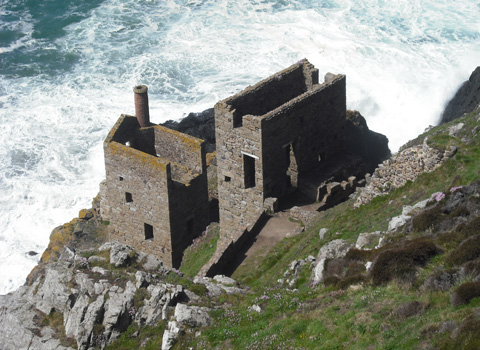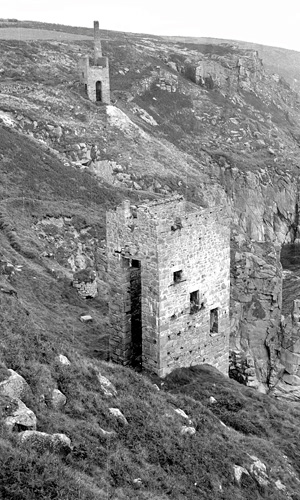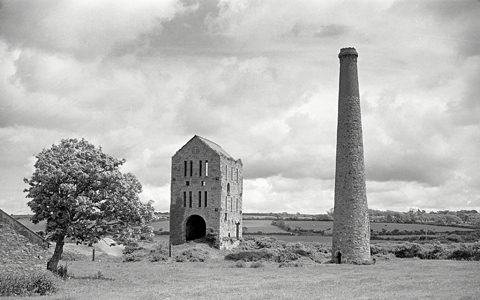
The engine houses of the dramatic Crowns section of Botallack Mine, near Pendeen. The lower house is that of a 30-inch pumping engine built by Harvey and Co. of Hayle and erected new on Crowns Engine shaft in 1835. The upper house is Pearce’s all-enclosed 24-inch winding engine moved to this site in 1862 to hoist from the then-new Boscawen diagonal shaft in the cliff below (2009).
October 2014 Geological Sciences Newsletter
Dr. R. Damian Nance grew up in the seaside town of St. Ives, Cornwall, U.K., fascinated by the mines and ruins that harkened to a century past when Cornwall provided the world with tin, copper and other riches.
At the center of Cornwall’s success—and the subject of Nance’s new book—was the Cornish beam steam engine that pumped water out of the mines.
Along with Kenneth Brown, Nance co-authored A Complete Guide to the Engine Houses of West Cornwall, which releases in May. Nance is Distinguished Professor of Geological Sciences at Ohio University.

The two cliff-edge pumping engine houses of Trewavas Mine, near Porthleven, taken in September 1967, showing the slot-like cylinder opening in the house on Old Engine shaft in the foreground, which was erected in 1834, and in the background, the house of a 45-inch engine built by Harvey and Co. of Hayle and erected on New Engine shaft in 1838.”
“Cornwall should be on everybody’s bucket list!” says Nance. “My roots are deep there. My forebear, John Nans, is known to have been vicar of Macaccan on the Lizard Peninsula is south Cornwall in 1386, and my father’s father, Robert Morton Nance, is almost a household name, having played a huge role is saving the Cornish language (kernewek) from extinction with the publication of his book “Cornish for All” in 1921, and for being Grand Bard of the Cornish Gorseth for 25 years. He was also a maritime historian, and both founded the Society for Nautical Research and helped set up the Maritime Museum in Greenwich, London. My other grandfather, Bernard Leach, is also a very well-known Cornish figure, having set up a pottery in St. Ives in 1920 and going on to become internationally famous as the “father of studio pottery.” His pots today are worth a fortune, and his landmark publication A Potter’s Book was published in 1940″

The all-granite engine house of Taylor’s 90-inch pumping engine (the last to be built in Cornwall) at East Pool mine, near Camborne. Built by Harvey and Co. in 1892 to the design of Nicholas Trestrail, the engine was first erected in 1893 on Highburrow East shaft at Carn Brea Mine where it was known as Harvey’s engine. It ceased work in 1914 and remained idle until 1924 when it was bought by East Pool and moved to Taylor’s shaft. (2010)
The Engine Houses of West Cornwall
“Nowhere in the world has metal mining been of greater importance than it has in Cornwall, and it is in recognition of this extraordinary heritage and the global influence of the pioneering technology developed here that the county’s mining landscape was named a UNESCO World Heritage Site in 2006 on a par with the Pyramids of Giza and the Great Wall of China,” says the Lightmoor website.
 During the 19th century, Cornwall produced most of the world’s copper and tin, as well as substantial quantities of lead, silver, arsenic, tungsten, zinc, iron and uranium. What made this unparalleled productivity possible was the development, pioneered by Cornishman Richard Trevithick, of the Cornish beam engine, a reciprocating steam engine capable of driving pumps that could keep the ever-deepening mines free of water.
During the 19th century, Cornwall produced most of the world’s copper and tin, as well as substantial quantities of lead, silver, arsenic, tungsten, zinc, iron and uranium. What made this unparalleled productivity possible was the development, pioneered by Cornishman Richard Trevithick, of the Cornish beam engine, a reciprocating steam engine capable of driving pumps that could keep the ever-deepening mines free of water.
Although few of these great engines survive, many of the buildings in which they were once housed remain to this day, forming characteristic features of the Cornish landscape that have come to symbolize the county’s rich mining heritage and now stand as silent monuments to the mining industry for which the county was once justly famous.

The house of St. Aubyn’s 80-inch pumping engine at Tregutha Downs Mine, near Marazion. Better known as Robinson’s engine (the name it acquired after its removal in 1903 to South Crofty Mine in Pool, where it is preserved), the engine was built in 1854 by Sandys, Vivian and Co. at the Copperhouse Foundry in Hayle to the design of Samuel Grose and had previously worked on Davey’s shaft at Alfred Consols near Hayle until 1864, and as Pelly’s engine at Crenver and Wheal Abraham near Crowan until 1876. It was set to work at St. Aubyn’s shaft at Tregurtha Downs on May 27th 1883. (1967)
This book introduces these remarkable engine houses by providing an illustrated guide to those in West Cornwall using contemporary and archival photographs supplemented with brief descriptions of the engines the buildings once contained, simple interpretations of some of their key features, and short histories of the mines of which they were part,” continues the Lightmoor description. “It is not an exhaustive treatment, nor is it meant solely for the enthusiast, but rather, it provides an overview intended for all those interested in these historically important structures.
Together, the authors bring over a century of expertise to this fascinating guide. Damian Nance is a St. Ives-born geologist with a lifelong interest and knowledge of Cornish engine houses, and Kenneth Brown is a leading expert on Cornish mining history and co-author of the highly popular “Exploring Cornish Mines” series.


















Comments